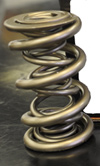Valve springs can't take Pro Stock revs
 Larry Morgan is the only driver in NHRA Pro Stock professional racing to have campaigned a Ford Mustang throughout the 2011 Full Throttle Drag Racing Series season. Although he came close, he didn't make the play-off Countdown to One.
Larry Morgan is the only driver in NHRA Pro Stock professional racing to have campaigned a Ford Mustang throughout the 2011 Full Throttle Drag Racing Series season. Although he came close, he didn't make the play-off Countdown to One.
He's developed the Ford's engine throughout last year and into this, and the major problem he's had with his engine is valve springs. Like most Pro Stock entrants, he's increased his rev range into the 11,000 rpm range and, as he says, "It's killing my valve springs."
The triple-spring item Morgan uses hasn't been able to last more than three runs without having to be replaced. "Think about that: since Brainerd [in August], I've got [through] $10,000 in valve springs," he said at Dallas in early October. "That's three events and four tests - so I hate to even fire the engine up on the dyno now."
The valve springs he's using first run at 470-500 psi. "We don't ever want them to go below 425 psi," Morgan says. "They'll start at 525 and lose 50 lb, and they stay in that area. My car will run better the second round because that's the second time those springs have taken a set."
On the other hand, he says, "They'll have less pressure on the engine the second round, and they'll run engine speed it takes to run, but I still have to change them. I have no choice."
The culprit for his failures is high engine speed, but if he backs off he won't make the show. "I feel bad for the valve spring companies because they are trying to supply us with good parts, and they're doing a good job - but we need better parts. They just can't stand the extra revs going from 10,000 rpm to 11,000 rpm. They just don't last as long as they should, and that's a shame."
He's shattered some valve springs and realises there's a chance of wrecking the rest of the valvetrain when that happens. "You tear the tip up into the pushrod, the adjuster up into the rocker arm and possibly wreck the end of the valve," he says. "I worry about what else it's doing when the spring breaks, like the valve tagging the piston. Valve release is perfect ,and if it does tag the piston it comes right back. Then you're having to change the valve, the gasket and the springs because you're not going to take a chance on running them out, unless you're an idiot."
The spring manufacturers have been looking at heat treatments to stop springs being so brittle. "They're trying different heat treatments and they're trying really, really hard," Morgan says. "It's possible they got some bad wire, and that's a problem in their business.
"We really think pneumatic springs are the way to go in this class. We've been pushing for this for years, but the NHRA won't listen to us. We'll spend close to $60,000 this year on valve springs for one car - that's a lot of money. We haven't changed our cam profile on any of these motors but the valve spring process has changed, and right now we're all having valve spring problems.
"We start making everything stronger with the camshaft, then the lifters, the pushrods and the rocker arms," Morgan explains. "Now we don't have a valve spring good enough to work with all that. It works, but you get no more than three runs on them, and it's got me devastated. I hate even to warm up the engine, because you're talking cycle time."
Fig. 1 - Larry Morgan uses intake valve springs that install at 525 lb at 2.300 in (Photo: Anne Proffit)
Written by Anne Proffit